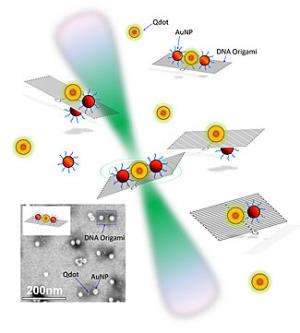DNA and quantum dots: All that glitters is not gold

(Phys.org)—A team of researchers at the National Institute of Standards and Technology (NIST) has shown that by bringing gold nanoparticles close to the dots and using a DNA template to control the distances, the intensity of a quantum dot's fluorescence can be predictably increased or decreased. This breakthrough opens a potential path to using quantum dots as a component in better photodetectors, chemical sensors and nanoscale lasers.
Anyone who has tried to tune a radio knows that moving their hands toward or away from the antenna can improve or ruin the reception. Although the reasons are well understood, controlling this strange effect is difficult, even with hundred-year-old radio technology. Similarly, nanotechnology researchers have been frustrated trying to control the light emitted from quantum dots, which brighten or dim with the proximity of other particles.
The NIST team developed ways to accurately and precisely place different kinds of nanoparticles near each other and to measure the behavior of the resulting nanoscale constructs. Because nanoparticle-based inventions may require multiple types of particles to work together, it is crucial to have reliable methods to assemble them and to understand how they interact.
The researchers looked at two types of nanoparticles, quantum dots, which glow with fluorescent light when illuminated, and gold nanoparticles, which have long been known to enhance the intensity of light around them. The two could work together to make nanoscale sensors built using rectangles of woven DNA strands, formed using a technique called "DNA origami."
These DNA rectangles can be engineered to capture different types of nanoparticles at specific locations with a precision of about one nanometer. Tiny changes in the distance between a quantum dot and a gold nanoparticle near one another on the rectangle cause the quantum dot to glow more or less brightly as it moves away from or toward the gold. Because these small movements can be easily detected by tracking the changes in the quantum dot's brightness, they can be used to reveal, for example, the presence of a particular chemical that is selectively attached to the DNA rectangle. However, getting it to work properly is complicated, says NIST's Alex Liddle.
"A quantum dot is highly sensitive to the distance between it and the gold, as well as the size, number and arrangement of the gold particles," says Liddle, a scientist with the NIST Center for Nanoscale Science and Technology. "These factors can boost its fluorescence, mask it or change how long its glow lasts. We wanted a way to measure these effects, which had never been done before."
Liddle and his colleagues made several groups of DNA rectangles, each with a different configuration of quantum dots and gold particles in a solution. Using a laser as a spotlight, the team was able to follow the movement of individual DNA rectangles in the liquid, and also could detect changes in the fluorescent lifetime of the quantum dots when they were close to gold particles of different sizes. They also showed that they could exactly predict the lifetime of the fluorescence of the quantum dot depending on the size of the nearby gold nanoparticles.
While their tracking technique was time consuming, Liddle says that the strength of their results will enable them to engineer the dots to have a specific desired lifetime. Moreover, the success of their tracking method could lead to better measurement methods.
"Our main goals for the future," he concludes, "are to build better nanoscale sensors using this approach and to develop the metrology necessary to measure their performance."
More information: Ko, S., Du, K. and Liddle, J. Quantum-dot fluorescence lifetime engineering with DNA origami constructs. Angewandte Chemie (Int. Ed.), 52: 1193–1197. doi: 10.1002/anie.201206253.
Provided by National Institute of Standards and Technology




















